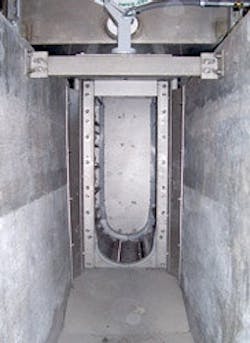Protecting an MBR system
Management of a 1.2 million gal per day (mgd) wastewater treatment plant (WWTP) in Star, Idaho, reports successful installation of a solids separation and removal system, which protects membranes in its new membrane bioreactor (MBR) addition. Meanwhile, immediate maintenance benefits have been gained through the elimination of aerator plugging in the facility’s three lagoons.
Installed in November 2005, the Monster Separation System integrates a Bandscreen Monster with a Screenings Washer Monster and provides an initial screening of solids and processes by grinding, washing, dewatering and compacting the unwanted material.
“The membranes in the new MBR plant are really expensive, and we wanted to be sure to have the best screening ahead of them, so we don’t get grit or other material that could damage them,” said Hank Day, maintenance and operations foreman for Star Sewer and Water District. “We also wanted to filter out as much total solids as we can, to keep the new MBR plant running at optimum capacity. This combination solids processing system allowed us to meet both objectives from the outset of the new plant operation. Anytime you’re dealing with wastewater, it’s a lot easier and cheaper to do it right the first time than to come back and add stuff later.”
The WTTP, which was opened to meet a dramatic increase in customer base, now serves about 2,000 residential customers and another 25 commercial operations. The lagoons were already filled near capacity.
At the WWTP’s headworks, a manual bar screen removes rags and other large matter. The flow then moves through a separator, which deposits to a 3-yd dumpster.
The remaining wastewater stream then enters the separation system, with 1/8-in. perforated ultra-high molecular weight bandscreens for removal of solids, such as trash and plastics. The solids are then grinded, washed, dewatered, compacted and discharged into the grit dumpster.
The effluent from the separation system proceeds through a flowmeter to a splitter box, which sends 20% of the stream to the three 1,600-equivalent-dwelling-unit lagoons and 80% into the new MBR plant. In the new plant, another splitter box sets up two separate treatment chains, where anoxic and anaerobic cells see mixtures of raw activated sludge, raw influent and mixed liquor from membranes, and provide biomass “bugs” for the MBRs.
The membrane portion currently consists of 200 flat-plate membranes per cassette and twelve cassettes for each train. Flow in the east and west trains is now about 0.3 mgd each. Allowance has been made for future expansion of the MBR capacity.
The MBR discharges to a chlorine contact basin for final disinfection before the effluent is discharged. The 1.2-mgd peak flow WWTP is presently operating at about 0.8 mgd.
“They’re building 20 new subdivisions in our area as we speak,” Day said. “To upgrade, we did everything at the very best we could afford and still be easy to operate. The Idaho Department of Environmental Quality lent us money to build it, and they like what they’ve seen so far.”
“The dumpster, which took about a month to fill up with ground material, now gets emptied every two weeks, only because we also fill it with trash. The cleanliness of the discharged solids (from the SWM) allow for hauling to a sanitary landfill, which was a compliance criterion that was assured by our engineers, Keller Associates of Meridian, Idaho,” Day said.
Justin Walker, project engineer for Keller Associates, said, “We’re pleased the MBR plant is operating as designed. The facility is producing great quality water.”
“We wanted to make sure organics were removed to reduce odor and ensure waste would be accepted at the landfill,” added Randy Zollinger, project manager for Keller Associates. “During our initial start up, we saw our decision to utilize the Screenings Washer Monster was justified as very little odor was generated from the washed compacted screenings.”
In considering alternatives, the WTTP settled on a bandscreen versus a step screen because it would let in fewer solids, and then specified a 1/8-in. size to meet the MBR manufacturer’s warranty, Day said. Additionally, the separation system was the easiest to operate and maintain.
“For example, it didn’t have any bearings down in the waterway, and you could take out sections of the belt without taking out all of it, which requires disassembling the whole unit,” Day said.
